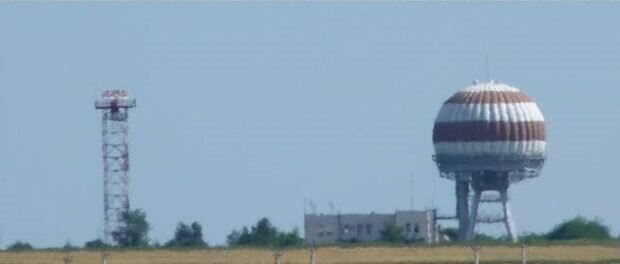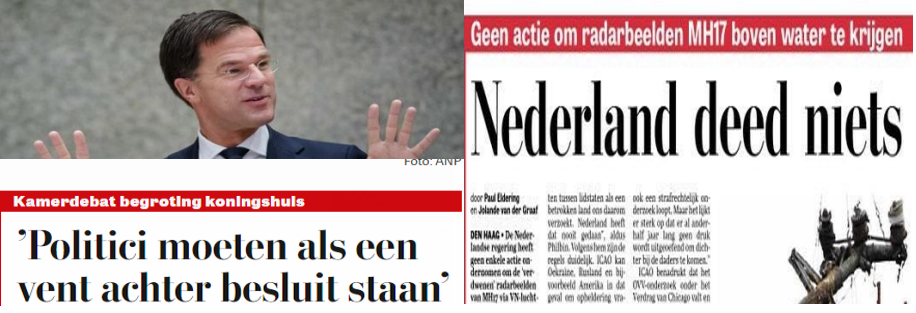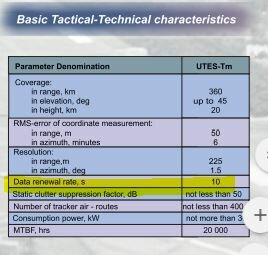Dutch public prosecution services makes doubtfull statement about Russian radar capability

Dutch Public Prosecution Service at May 15 2017 published a progress report on the criminal investigation into the downing of MH17. This was done in a ezine format here.
One of the topics covered is the radar recording. Russia handed over radar recordings in October 2016 to the Dutch Prosecution Service. However in 2014 Russia stated to Dutch Safety Board it did not have any recordings. As a coincidence in September 2016, two days before JIT presented its preliminary results, Russia showed radar images during a press conference.
Russia stated there was no BUK missile detected on the radar.
Dutch Public Prosecution Service stated in the May 2017 published ezine (screenshot here):
If the BUK missile could not be seen on the RF radar images, it did not mean that the BUK missile had not flown there. After all, a radar scans its environment in a circular motion and therefore this environment is not permanently displayed. As a comparison you can think of the way in which a lighthouse illuminates its surroundings. It may be so that the radar was just working on the other side of its scanning round at the moment that missile was launched.
This last sentence does not make much sense !
In this post titled ‘Russia lied about radar capabilities, modified radar images and omited radar images‘ I explain the details about the Russian radar.
Russia showed images taken from the Utes-T radar. The radar antenna does a full rotation in 10 seconds. This was all confirmed in the September 26 press conference of Almaz Antey. The rotation speed can be found in various documents as well. For example here.
The rotation speed of the radar is proven in this video.
At 16:51 into the video you see a small line turning 360 degrees. This line indicates the direction the radar antenna is facing. You will notice than when the line faces MH17, the target position moves, indicating a refresh of the position. The time to make a full circle is exactly 10 seconds.
Now lets look at the time the BUK missile needed to reach MH17 when launched from a field south of Snizhne. The geodesic distance—that’s distance as the crow flies, or the literal shortest route between two points between the supposed launch location and the location where the Flight Data Recorder stopped is roughly 24 kilometers.
The trajectory of the missile is longer as it first climbed verticaly and then changed its path to a horizontal route.
The speed of the missile is not the same during the complete route. In the beginning it is faster than in the final phase. DSB estimated a speed of 730 m/s in the final phase of the flight.
This make the missile required about 30 seconds to reach MH17 after launch.Russia stated in Almaz Antey press conference even 32 to 36 seconds when launched from south of Snizhne.
Assuming the radar horizon of the Utes-T radar is about 2 km, which takes the missile 4 seconds to reach (confirmed by Almaz Antey press conference at September 28) , the duration of the missile flight which could be detected by the radar is 27 seconds or 22 seconds. As the antenna of the radar does a full rotation in 10 seconds, the missile must have been detected at least twice.
Almaz Antey stated that the radar could even have detected the missile 4 times. Almaz states the possibility that only 2 marks were detected is low. The probabilty that at least one time a detection was made is over 95%.
Caveat
There is a small caveat in my argumentation. Dutch Prosecution Service states “it may be so that the radar was just working on the other side of its scanning round at the moment that missile was launched.”
A radar capability of detecting objects depends on the object Radar cross-section (RCS). RCS is a measure of how detectable an object is with a radar. A larger RCS indicates that an object is more easily detected.
It could be the RCS of the missile when in a vertical position or at an angle like 45 degrees had a RCS which is just enough to be detected by a radar located in Ust-Donetsk.
It could be the RCS decreases when the missile changes to a more horizontal position while flying away from the radar.
If this is the case it could be the radar could only detect the missile during launch. However in that phase of the flight it could well be the missile was below the radar horizon. Something not mentioned by the Dutch Prosecution Service.
Conclusion
It seems unlikely Russian radar did not detect the missile because the radar was just working on the other side of its scanning round at the moment that missile was launched.
If radar did not detected the missile, it is because it was under the horizon at the first rotation of the radar and the RCS was too low at the second, third and forth rotation.


Any radar has a maximum detectable radial velocity of targets, above which due to Doppler shift the frequency of reflected return signal simply comes out of the range the radar could process. No such figures are publicly available for Utes-T, but for a civil ATC radar it is reasonable to have the limit just slightly above the maximum speed of civil jets. So a missile could really be undetectable during its supersonic flight with a civil radar, even if its RCS is sufficient, and radar’s raw data is not forged (it is surely forged in this case, but hardly that lay in a missile being removed). I don’t know what Dutch Public Prosecution Service meant exactly, but of course it should formulate such statements in a professional way, not like this was done in the ezine.